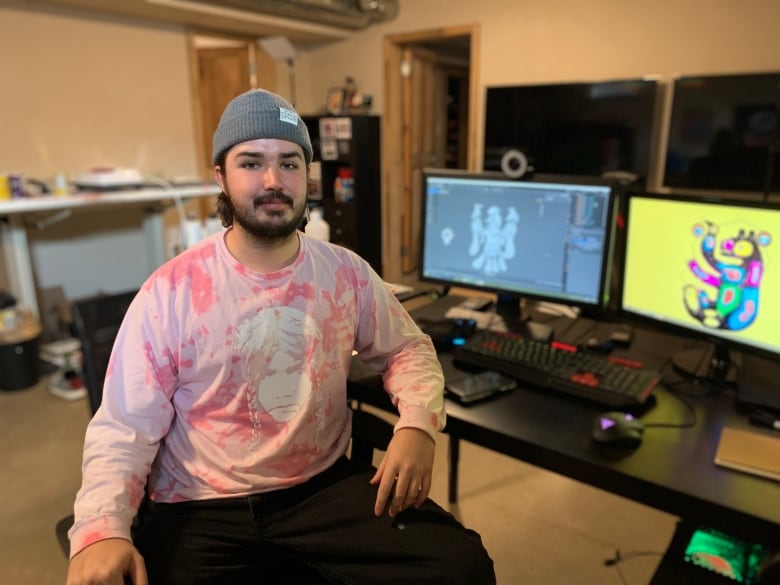Imagine creating something that makes you money over and over and over again. Twenty-two-year-old Anishinaabe artist Quinn Hopkins hopes to do that by selling his work on a new market.
His digital piece, based on Norval Morrisseau’s Medicine Bear, sold on an NFT marketplace within four days of it being posted.
“I was super excited to share it,” said Hopkins.
“I got an amazing reaction from everyone; it’s motivated me to start creating more.”
An NFT or non-fungible token is a new way of authenticating unique digital art and selling it.
Something that is fungible is not unique, like an iPhone but if you apply art to an iPhone or make it 3D, it becomes unique, making it non-fungible. Attach that 3D iPhone to a token and that is how you get a non-fungible token.
The token keeps artists connected to their creation after they sell it. The sale to the new owner is recorded on a ledger but the artist remains the creator and earns a commission for all secondary sales. For Hopkins, that’s 10 per cent.
He said selling his 3D bear is paying off in many ways.
“It’s honestly so gratifying,” he said.
“I spend a lot of time making these pieces. It’s paying off in more ways than one . . . . I am meeting so many interesting people and learning a lot in the process.”
‘Art helped me heal and reconnect’
Hopkins grew up in Mississauga, Ont., disconnected from his culture, but said it was always part of his identity.
“In my summers I would visit Batchawana Bay up in Lake Superior where my grandma was from . . . and I felt that connection.”
He found something else that evoked his identity when he discovered contemporary Indigenous art.
“I’ve always looked up to Norval Morrisseau,” he said.
“When I was growing up, my best friend — his family are major Indigenous art collectors. They have a beautiful home collection of Morrisseaus, Odjigs, Alex Janviers. Some of my favourite artists are from their collection.”
Anishinaabe artist Quinn Hopkins, 22, has sold a digital 3D piece based on Norval Morrisseau’s Medicine Bear on a new marketplace for non-fungible token art. 2:51
Although Hopkins grew up surrounded by the works of inspirational First Nations artists, his journey into the art world didn’t start until university.
“I was in engineering at UBC and I developed pretty severe depression and art helped me heal and reconnect with my heritage and be part of this resurgence of culture,” he said.
Hopkins is now a student at the Ontario College of Art and Design University in Toronto. When the COVID-19 pandemic prompted virtual classes, he started focusing on digital art.
The pandemic also changed the traditional way of showcasing art in gallery exhibitions, giving artists like Hopkins the idea of creating pieces that owners can display wherever they want.

Like owning a picture of the Mona Lisa
Hopkins compared owning NFT art to one of the most recognized paintings in the world.
“It’s kind of like owning a picture of the Mona Lisa,” he said.
“You don’t own the Mona Lisa. You don’t own the original file or picture or painting . . . . It’s undeniable that the Louvre . . . owns it.”
It’s that type of ownership that’s attracting people to buy NFT art. Jack Dorsey, the CEO of Twitter, is selling his first Tweet as a non-fungible token, and the highest bid so far is $2.5 million. Dorsey plans to donate his earnings from the sale to charity.
Hopkins said the NFT market is a desirable place for artists trying to make a living. He said he is aware of the carbon footprint it makes, consuming energy, but as an entrepreneur he said he plans to address that.
“I have big plans for the future of the Indigenous NFT community,” he said.
He is joining forces with up to 15 Indigenous artists to create a community.
“I wanted to just create more of a site, bring everyone together. And really, especially in these times where it’s hard to connect with other people, we can connect through social media,” Hopkins said.





